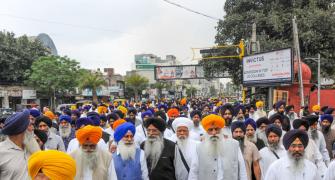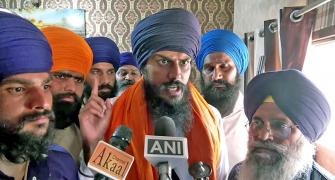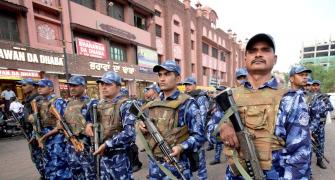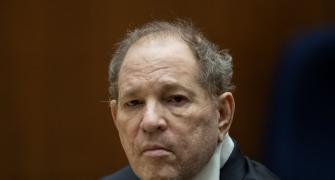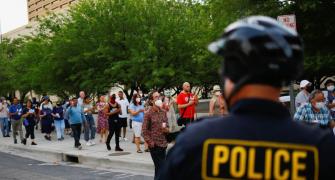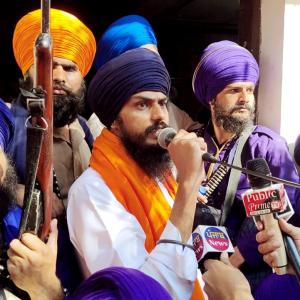'Khalistanis can be divided into three categories: Firstly, hardcore ideological people. They are microscopic, not even 1%.'
'Secondly, those who consider Khalistan a business.'
'The third category that has built the narrative of Khalistan are those who gain from polarisation.'
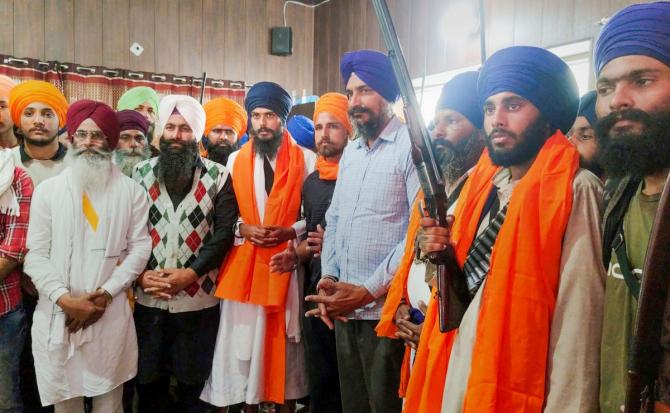
"Punjabi society cannot be tackled from the point of view of the personal interest of particular parties," says Ramesh Inder Singh, former chief secretary of Punjab and district magistrate of Amritsar during Operation Blue Star.
Thirty-seven years after Operation Blue Star, R I Singh has written Turmoil in Punjab: Before and After Blue Star, An Insider's Story, a fascinating account of the genesis of the Punjab conflict, the rise of Sikh radicalism and the elimination of militancy.
"The Sikh community has to be tackled with tact," he tells Rediff.com's Archana Masih and Nikhil Lakshman discussing the delicate faultlines that continue to exist in Punjab decades after Op Blue Star.
The second of a multi-part interview:
- PART 1 of the Interview: 'Khalistanis are a microscopic minority in Punjab'

As a former chief secretary of Punjab, what is it about episode Amritpal that strikes you as most bizarre?
Delayed action is not a prudent management of law and order. I can appreciate the restraint exercised by the Punjab police at that particular spot in Ajnala as a tactic because Amritpal brought the Guru Granth Sahib and played to human sentiment. But he had travelled almost 60-70 kilometres and should have been intercepted and arrested on that route.
There's speculation that he has been propped up by certain agencies?
It has been often mentioned that he might have been propped up, but I have no knowledge or information. He was a clean shaven taxi driver in Dubai who suddenly appeared from nowhere. There are stories that he went to Georgia also for a while, so anybody could have trained and brought him. Only time will tell.
There are many disclosures in my book that were not known earlier and are eye openers because various forces were playing all kinds of roles [in the run-up to Blue Star].
For example, the Congress published a six-seven volume history of the Indian National Congress on its 125th anniversary with a forward by Sonia Gandhi. It includes articles by various people where they acknowledge that they propped up Jarnail Singh Bhindranwale.
They did not create Bhindranwale because he was already head of a seminary. But the situation suited both. However, their objectives were different.
The limited objective of the Congress was to capture political power; while Bhindranwale's objective was to capture the Shiromani Gurdwara Prabhandak Committee [the organisation responsible for the management of gurdwaras]. What the Congress could not do as a secular party, it outsourced to others.
These disclosures have come now and the information about who is behind Amritpal will also be known in time, but to speculate may not be very wise.
You can analyse three possibilities: ISI, Sikh organisations based abroad like Sikhs for Justice, any of the political parties or some other factors.
How has he been able to establish such a following?
The following is because of the level of unemployment and the tradition and history of struggle in Sikhism. The Sikh community has to be tackled with tact.
For example, the Sikh empire was defeated by the British in two battles during Maharaja Ranjit Singh's time. The same Sikh army, within a few decades, went all over the world fighting for the British.
How did it happen? The British were able to handle them with psychological tact.
In fact, there are many British historians who have gone on record, and I have quoted one of them. A governor said that if you confront the Sikhs, they will retaliate. If you win them over, they will join you.
Coming back to today's context, this is a world of polarisation and polarisation pays -- earlier, it paid a political party; today it may pay some other political party.
He has not been arrested though there is a manhunt for him. So, where do you see this leading?
The simple answer to your question would be that if he's not traced and arrested now, there could possibly be some involvement somewhere and he will be arrested closer to the election.
If some force within the country has got him, then probably that sponsorship was premature and it has matured a little too early to give results. If that is so, then his arrest may happen six-seven months from hence.
Did the vacuum created by the eclipse of the Congress and Akali Dal result in the emergence of Amritpal?
There is a vacuum of moderate leadership. In Punjab, both the Akali Dal and BJP were moderate forces. Whenever they have allied together since 1966 onwards, Punjab has progressed and been peaceful.
The population is more or less evenly balanced. Sikhs were 62%, but in absence of the 2021 Census, my guess estimate is that Sikhs must be 53%-54%. Their birth rate has come down to 1.6% and the replacement rate is 2%; added to that is their exodus abroad.
Many people are migrating to Punjab from other parts of India. In various towns and cities of the state, lower level jobs are being done by non-Punjabis -- for example, textile factories etc. Hence, there is a balancing out of the population in terms of Sikhs and non-Sikhs.
There was also a spurt in the preaching of Christianity; some pastors suddenly popped up proclaiming medical cures which were viewed as a threat by the radicals. This may have prompted them to be more aggressive in adopting these tactics.
Punjabi society cannot be tackled from the point of view of the personal interest of particular parties. The liquidation of the moderate leadership -- of course, they have themselves to blame because it was their own conduct that alienated and created the vacuum that brought AAP to power.
If AAP does well and can fill in the space of the moderates, and provide economic development to the state, then maybe things may improve.
But one doesn't know, because as of today, the focus of AAP is limited to freebies. It may get them votes, but it will may not solve the problems of Punjab.

How big an issue is Khalistan?
Khalistan is a non-issue created by the media.
Firstly, Bhindranwale never openly asked for Khalistan. His first statement to Mrs Gandhi was that if you want to give it to me, I will not say no.
The second statement, made just before Blue Star, was that if the Indian Army attacks the Golden Temple, then the foundation of Khalistan will be laid.
These are the only two statements attributable to him.
The panthic community declared the formation of Khalistan from the Golden Temple in April 1986. It was an ISI sponsored move, but subsequently the militant movement split into 17-18 smaller groups.
I have also mentioned in my book that (then Pakistan president and military dictator) Zia-ul Haq went into a rage when he saw the map of Khalistan prepared by some of the [Sikh] militant organisations.
No Sikh organisation will ever have a Khalistan without including the birthplace of Guru Nanak in [Nankana Sahib in Pakistan] and Lahore, the historical capital of the Sikhs.
Pakistan's aim was not the creation of Khalistan, but to create havoc in India and to bring the Hindus and Sikhs into conflict. The objective was to create a situation where Sikhs from other parts of India migrated to Punjab and Hindus moved out of the state.
The Sikh and Hindu communities are bound by an umbilical cord, so the tactic employed was to start dividing friends by small steps. It started around 1981 by throwing bidis into gurdwaras or the tail of cows in temples.
On many occasions, the two communities came out on the street against these moves. Then they slowly upgraded to jalsas and marches to divide people -- this is what Pakistan was doing.
Post Operation Blue Star, the anti-Sikh riots and Mrs Gandhi's murder, a survey was conducted in Punjab by Delhi University. According to the survey only 5% of the Sikh population in Punjab was sympathetic to the cause of Khalistan and this group largely comprised youngsters and educated, unemployed, youth.
Today also, Khalistanis can be divided into three categories: Firstly, hardcore ideological people. They are microscopic, not even 1%.
Secondly, those who consider Khalistan as a business. I've given you the example of Simranjit Singh Mann who is a member of the Lok Sabha and supports Khalistan. He openly says he gives letters on his letterhead in exchange for money.
The third category that has built the narrative of Khalistan are those who gain from polarisation.
The media played it up as if Amritpal set up an alternate government in Punjab! It suits certain segments of the media as well as certain political forces.
But the common people of Punjab hardly talk of Khalistan.

